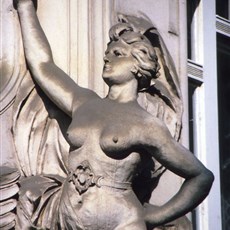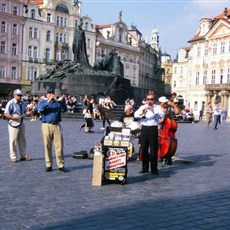1999 Biking East Europe
Friday, September 17 – Prague, Czech Republic
– Sport Camp, 400Kc
Exchange rate: 34 Korun ceskych (crowns) :
$1
We are seated on a terrace in Prague overlooking the Vltava River
and the Charles bridge with the setting sun casting golden light across the
ripples and two young lovers adrift in passion kissing long in a boat adrift –
much to the enjoyment of the restaurant trade as well as passing tourist boats.
We cashed 500Kc at the station on arrival
at about 06h00 and persuaded a taxi driver to drop at us the Sport Camp at the
west end of town where we have a basic but clean two-bed cabin for 400Kc per
night and shared ablutions. We are down to $25 per day and are having to be
careful.
Slept and showered and borrowed tram
tickets from the reception for the trip to Wenceslas Square and a bank. Cashed
traveller’s cheques – getting 34-odd Kc per USD – and had coffee and beer in a
nearby cafe. Then bought three-day transport passes at the metro (having
decided not to use our bikes in the city – too busy, too many cobbled streets,
too easy to get around via public transport) and headed for the Josefov area on
yet another beautiful day.
In the late-1800s it was decided that Prague should be turned into a bourgeois city based on Paris and to this end the
Josefov Jewish ghetto was to be ‘sanitised’ – a process begun in 1883. By World
War II, all that remained of the original ghetto was six synagogues, the town
hall and the medieval cemetery. All the other buildings had been replaced with
luxurious five-storey mansions and the area is now “rich in Art Nouveau
buildings festooned with decorative murals, doorways and sculpturing”. By an
odd quirk of fate what little remained of the ghetto survived the Nazi
occupation too, Hitler having decided the area would make a good “Exotic Museum
of an Extinct Race”! We didn’t go into any of the buildings, just marvelled
from the outside. Particularly at the cemetery which was used from the 15th
century until 1787 by which time it was said to contain 100 000 corpses – many
buried atop each other in as many as 12 layers.
We strolled agog and at random through the
streets along which every building is worth studying. Around every corner, a
cafe or bar or restaurant or shop selling Bohemian glass. The lampposts are
photographic material, as are the doors, the drainpipes, the manhole covers – never
mind the walls and, my favourite, the roof tops. We peered through the gate at
the Jewish cemetery, window-shopped and wondered.

Prague

Prague

Prague

Prague

Prague
Later we bought lunch goods at a minimarket – rolls (first real bread selection encountered on this trip), salami, peppered cheese, beer and coke, booked Mozart tickets and, quite by accident in search of somewhere to sit for our picnic lunch, found ourselves in the spectacular Old Town Square. Mind-blowing, overwhelming, stunning. From the 11th century onwards this was the city’s main marketplace and the scene apparently of violent demonstrations and battles over the years. The 18th century baroque facades on the surrounding buildings front houses dating from way way back. My favourite building amongst all this splendour was a simple warm stone-coloured affair with unpretentious gables and lovely proportions. With the steeples – “bristling with baubles, spires and pinnacles” – of the Gothic Tyn church serving as a backdrop to it.
We sat at the base of the Hus monument (commissioned 1900, completed 1915) and devoured both the moving scene around us and our delicious lunch. Then wandered around under a hot sun photographing statues holding buildings aloft, or adorning roofs or pillars. Just couldn’t get enough.

Old Town Square

Old Town Square

Old Town Square
At both 16h00 and 17h00 we joined the tourist throng at the base of the Astronomical Clock to watch the mechanical performance prior to it donging the hour. “The Apostles shuffle past the top two windows, bowing to the audience, while perched on pinnacles below are the four threats to the city as perceived by the medieval mind: Death carrying his hourglass and tolling his bell; the Jew with his moneybags (since 1945 minus his stereotypical beard); Vanity admiring his reflection; and a turbaned Turk shaking his head. Beneath the moving figures, four characters representing virtues stand motionless throughout the performance. Finally, a cockerel pops out and flaps its wings to signal that the show’s over; the clock then chimes the hour.” The clock has been on the square since the early-1400s; the figures since 1490. The complex clock face tells current time, Old Bohemian time and Babylonian time as well as charting the movement of the sun and planets around the earth (as perceived then) and the movement of the sun and moon through the signs of the Zodiac. All in all pretty impressive.
In one of the side roads I was sorely tempted by an expensive puppet – a Turk with the severed head of a young woman in his hand. Instead we sat in a classy little place down a narrow alley to imbibe liquid refreshment and try to assimilate all we had seen, and then made for the Charles Bridge (Karlov Most). We didn’t make it onto the bridge, but did sit near it and admire it before heading for the highly-recommended Vulture (Restarace du Supa) for a just-above-mediocre dinner. Then to the Reduta Jazz club where we decided the 120Kc entry fee would have to wait for another day (Clinton played the sax here one night) and home on tram 9 for the long walk up our hill. Great day.

Astronomical clock

Astronomical clock